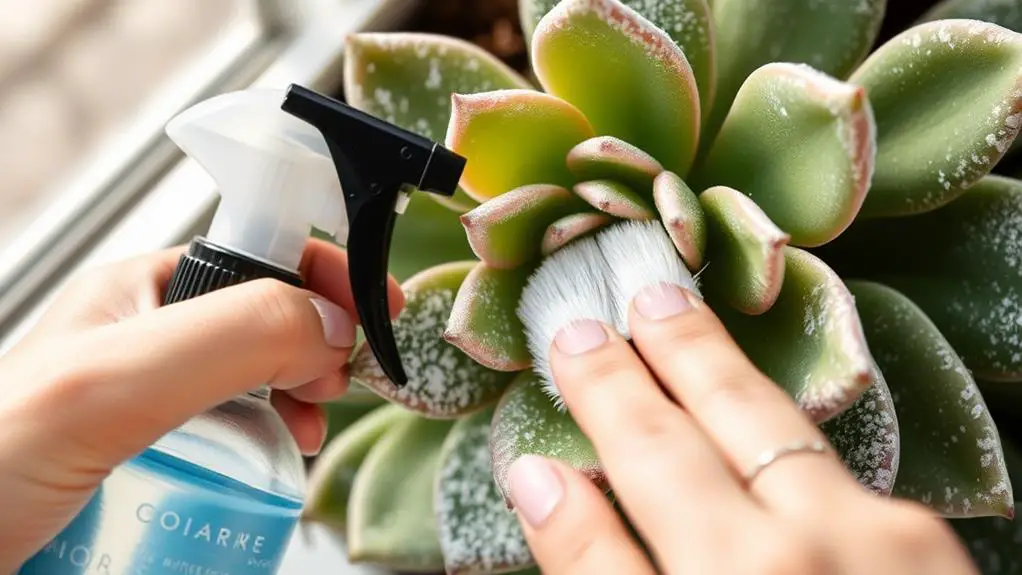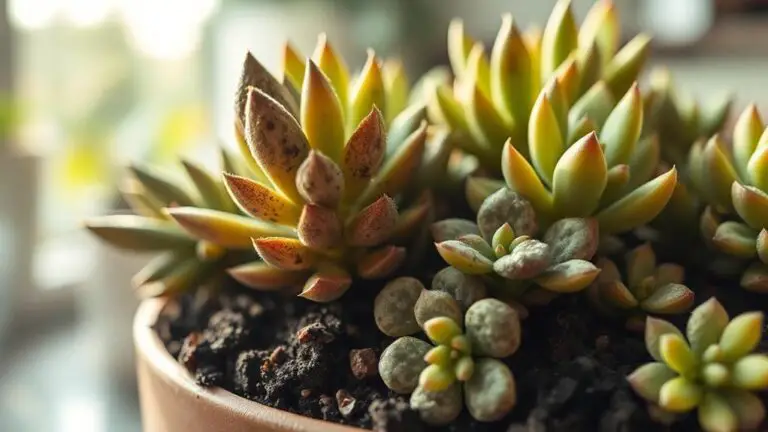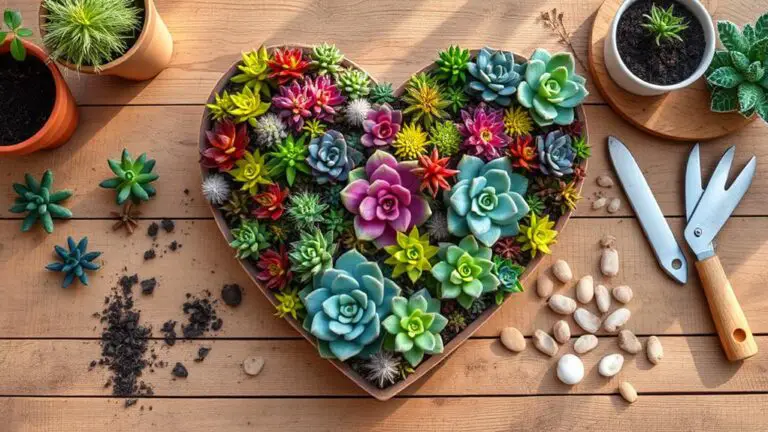How to Treat Powdery Mildew on Succulents
You've just noticed a white, powdery substance on your favorite succulent, and you're wondering what to do next. Powdery mildew can be a persistent problem if not addressed promptly. Start by isolating the infected plant to prevent the mildew from spreading to others. Natural remedies like baking soda solutions or milk sprays can be effective, but knowing when and how to use them is vital. Severe cases might require chemical fungicides. But before you reach for any treatment, let's explore the symptoms, causes, and identification methods to guarantee you're tackling the problem correctly.
Understanding Powdery Mildew
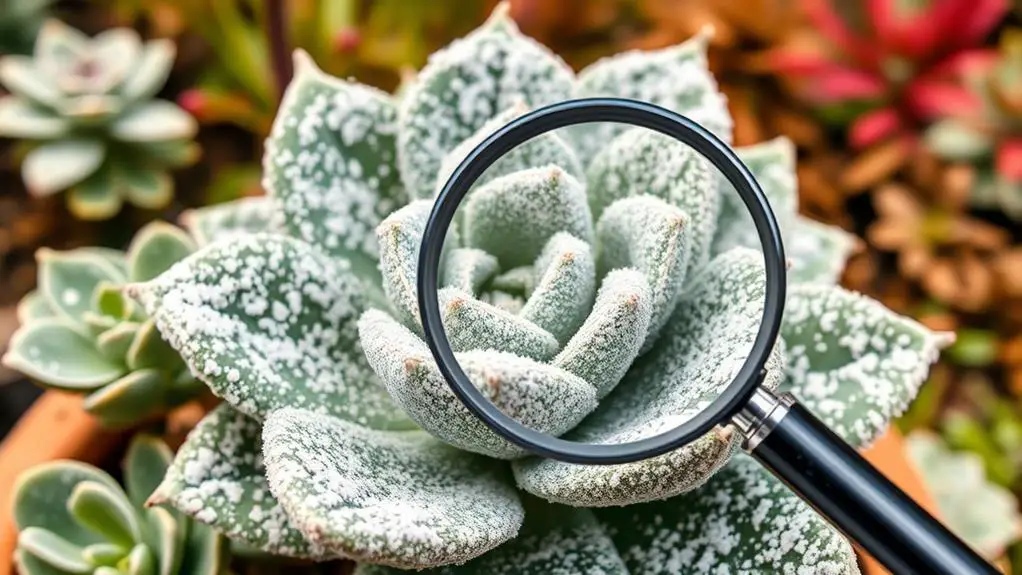
Powdery mildew, a common fungal disease, primarily affects succulents through fungi from the Erysiphaceae family, manifesting as white to grayish powdery patches on leaves and stems. You might notice it first on the affected leaves, looking like someone dusted them with flour.
This fungus loves warm, dry climates, especially when temperatures range from 70-80°F. It thrives in high humidity at night, which is why it's vital to understand the conditions that promote its growth.
Unlike many other fungal diseases, powdery mildew prefers dry foliage. It doesn't need water on the leaves to attach and spread. Instead, it relies on the nighttime humidity for spore germination. The spores are airborne, spreading quickly through wind, insects, and even contaminated gardening tools. This makes early detection absolutely essential for control.
To keep your succulents safe, it's important to regularly inspect them. Look for those initial white patches on the leaves. By spotting powdery mildew early, you can take steps to manage it before it causes any significant damage.
Understanding how powdery mildew operates will empower you to protect your succulents effectively.
Symptoms of Powdery Mildew

When you notice white or grayish powdery spots that feel like baby powder on your succulent leaves, you're likely seeing the first symptoms of powdery mildew.
These spots often start as small, circular patches, which can lead to yellow-brown discoloration and even blackening if not treated.
Keep an eye out for leaf distortion and curling, especially in new growth, as these are also signs of infection.
Visible Powdery Coating
Spotting powdery mildew on your succulents can be alarming, but recognizing its symptoms early is essential to effective treatment.
Powdery mildew typically appears as white or gray powdery spots on the surface of leaves and stems, resembling a dusting of baby powder. At first, you might notice small, circular patches. These can grow and merge, covering larger areas and leading to more severe discoloration on your plant.
Infected leaves often show signs of distortion, such as curling or puckering, especially in new growth. It's important to differentiate between powdery mildew and farina, the natural protective coating on some succulents. Farina appears uniform, while powdery mildew shows uneven spots.
Early detection is vital. If you catch it early, you can prevent the spread of powdery mildew to other plants.
Keep an eye on your succulents and act quickly if you see any suspicious powdery coatings. This vigilance guarantees more effective treatment and helps you maintain a healthy, beautiful garden.
Leaf Discoloration Signs
Keep an eye out for leaf discoloration, one of the essential symptoms of powdery mildew on succulents. This fungal infection often starts with small, circular white patches on the leaves. These patches can spread quickly, covering more of the leaf surface. As the infection progresses, you might notice the white patches turning yellow-brown, which is a sign of further leaf damage.
In addition to leaf discoloration, infected leaves may start curling or puckering. This indicates that the plant is struggling against the fungal infection. New growth on your succulents is particularly vulnerable. You'll want to look out for any new leaves developing black spots or turning completely brown, which can lead to them dying off.
Regular monitoring for these symptoms is vital. Catching the infection early means you can treat it more effectively. Here's a quick reference table to help you identify the symptoms of powdery mildew:
| Symptom | Description | Action Needed |
|---|---|---|
| White patches | Small, circular spots on leaves | Begin treatment immediately |
| Yellow-brown patches | Progression from white patches | Continue monitoring closely |
| Curling/puckering | Signs of leaf distress | Treat and care for the plant |
| Black spots or brown leaves | Severe infection signs | Remove affected leaves |
Causes of Powdery Mildew

Powdery mildew on succulents is caused by fungi that love warm temperatures and high humidity.
These fungal spores spread easily on warm, breezy days and thrive in humid nighttime conditions.
Factors like poor ventilation, nighttime watering, and overcrowding of your plants can increase the risk of this pesky problem.
Fungal Spore Dissemination
When it comes to fungal spore dissemination, understanding the causes of powdery mildew is essential for effective prevention and treatment. Fungal spores, the tiny agents of powdery mildew, primarily spread through the air. On warm, breezy days, these spores can travel long distances, making it easy for them to infect multiple plants.
High humidity, especially at night, creates the perfect conditions for these spores to germinate and spread rapidly. If your plants are overcrowded or spaced too closely, poor air circulation can trap moisture, increasing the risk of powdery mildew. Make sure your succulents have enough room to breathe.
Direct contact between infected and healthy plants also allows spores to spread. Monitor your plants closely and isolate any that show signs of infection. This will help stop the mildew from spreading further.
Don't forget about your gardening tools. Contaminated tools can transfer fungal spores from one plant to another. Always sanitize your tools after using them on infected plants.
Optimal Growth Conditions
To cultivate healthy succulents, it's crucial to understand the ideal growth conditions that can inadvertently promote powdery mildew. This fungal growth thrives in specific environments that might seem perfect for your plants but can also lead to problems.
Firstly, powdery mildew loves warm temperatures, especially between 70-80°F. This range is great for succulents but also encourages fungal growth and spore formation.
Secondly, high humidity, particularly at night, creates an ideal environment for powdery mildew spores to germinate. This means your succulents are more likely to get infected when it's humid.
Here are four key points to keep in mind:
- Temperature: Keep your succulents in a warm but not overly hot environment.
- Humidity: Reduce nighttime humidity levels to prevent spore growth.
- Air Circulation: Maintain good airflow around your plants to lower humidity.
- Watering Time: Water your succulents in the morning to avoid high nighttime humidity.
Risk Factors Overview
Understanding the risk factors for powdery mildew is essential for preventing this common issue in your succulents. This fungal disease thrives in warm, dry climates with temperatures between 70-80°F and high humidity at night. If your succulents are exposed to these conditions, they're at a higher risk for powdery mildew.
Poor air circulation is another major risk factor. When your plants are overcrowded, air can't move freely around them. This creates a perfect environment for fungal diseases like powdery mildew to spread. Make sure to space your succulents properly to let them breathe.
Nighttime watering can also be a culprit. Excessive moisture on the leaves at night encourages fungal growth. Instead, water your succulents in the morning so they've time to dry out during the day.
Pay attention to the wind, too. Spores from powdery mildew can easily spread on warm, breezy days. Keep an eye on nearby plants and remove any infected ones to prevent the spread.
Lastly, using too much nitrogen fertilizer might seem like a good idea for lush growth, but it can make your succulents more susceptible to powdery mildew. Stick to balanced fertilization to keep your plants healthy and less prone to fungal diseases.
Identifying Powdery Mildew
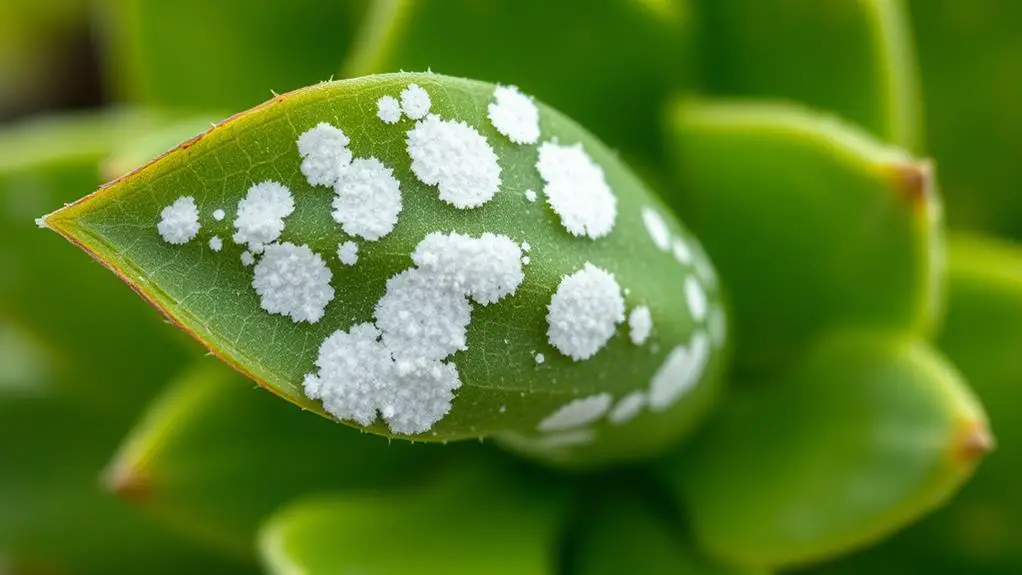
Spotting powdery mildew on succulents involves recognizing distinctive white or gray powdery spots on the leaves and stems, which look like a dusting of baby powder.
You'll notice these powdery spots appearing mostly on the surface, making it easy to catch early. It's essential to know what to look for to take action promptly.
Here are the key signs to identify powdery mildew:
- Powdery Coating: A white powder coating that feels slightly textured when you touch it.
- Uneven Spots: Unlike farina, which is uniform, powdery mildew shows up as uneven white or gray spots.
- Progression: Early stages show small circular patches that can expand and turn yellow-brown or black.
- Surface Infection: The powdery mildew mainly stays on the surface, making it easier to detect before it causes severe damage.
Regularly examining your succulents, especially during warm and humid conditions, can help you spot these early signs.
If you see white powder on your plant's leaves and stems, it's time to take action. Identifying powdery mildew early will make treating it much easier and keep your succulents healthy and thriving.
Stay vigilant and you'll be a step ahead in maintaining your garden.
Isolating Infected Plants
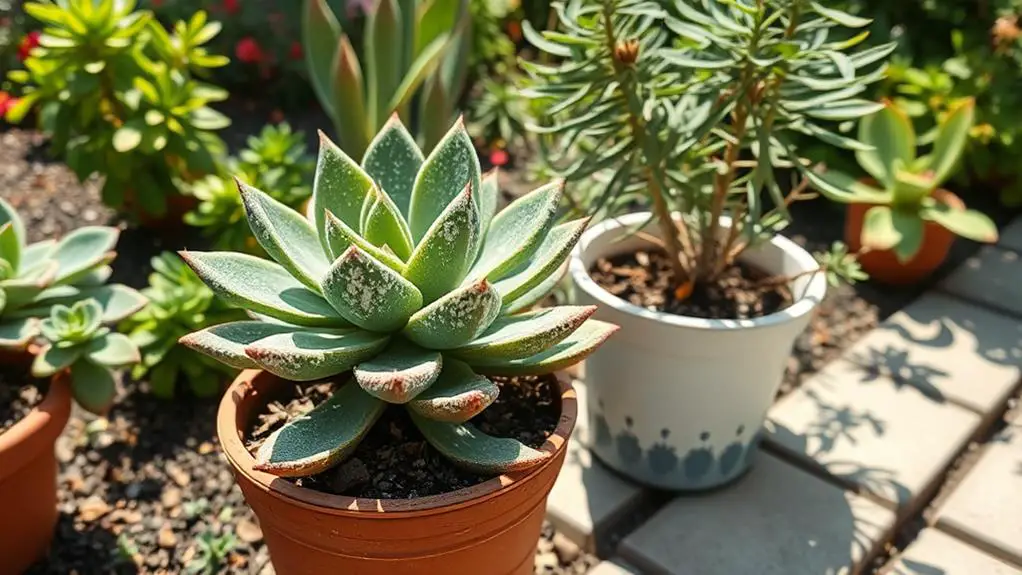
When you spot powdery mildew on your succulents, your first step should be isolating the infected plants to protect the rest of your collection.
Powdery mildew spreads through airborne spores, so moving infected succulents away from healthy ones is essential. If your infected plant is in a container, place it in a different area with good air circulation. This helps reduce humidity, which can slow the spread of the disease.
In garden settings, you might need to treat the affected plants in place, especially if moving them is impractical. However, if the infection is severe, you may need to remove the entire plant to protect the rest of your garden.
While your plants are isolated, keep a close eye on them. Regularly check for signs of disease improvement or further infection. This will help you monitor the effectiveness of your treatment and adjust as needed.
Always use clean, sterilized tools when handling infected succulents. This prevents spores from transferring to healthy plants.
Isolation might seem like a big step, but it's an important part of keeping your succulent collection healthy and thriving. By taking these precautions, you're giving your plants the best chance to recover.
Natural Treatment Methods

After isolating your infected succulents, it's time to explore natural treatment methods to combat powdery mildew. By using natural remedies, you can safely treat your plants without harming the environment or your health.
Here are some effective methods to contemplate:
- Baking Soda Solution: Mix two tablespoons of baking soda with one tablespoon of non-detergent soap and one gallon of water. Spray this weekly on your succulents to inhibit the powdery white spots caused by mildew.
- Milk Treatment: Combine one part milk with ten parts water and spray it on your succulents weekly for 3-4 weeks. Milk contains antifungal properties that naturally combat powdery mildew.
- Potassium Bicarbonate: Create a mixture using potassium bicarbonate, soap, and water in a 2:1:2 ratio. Apply it weekly to effectively target mildew spores on your plants.
- Neem Oil Addition: Enhance any of the above mixtures by adding neem oil. This natural fungicide boosts their effectiveness, providing an extra layer of protection against powdery mildew.
Chemical Treatment Options
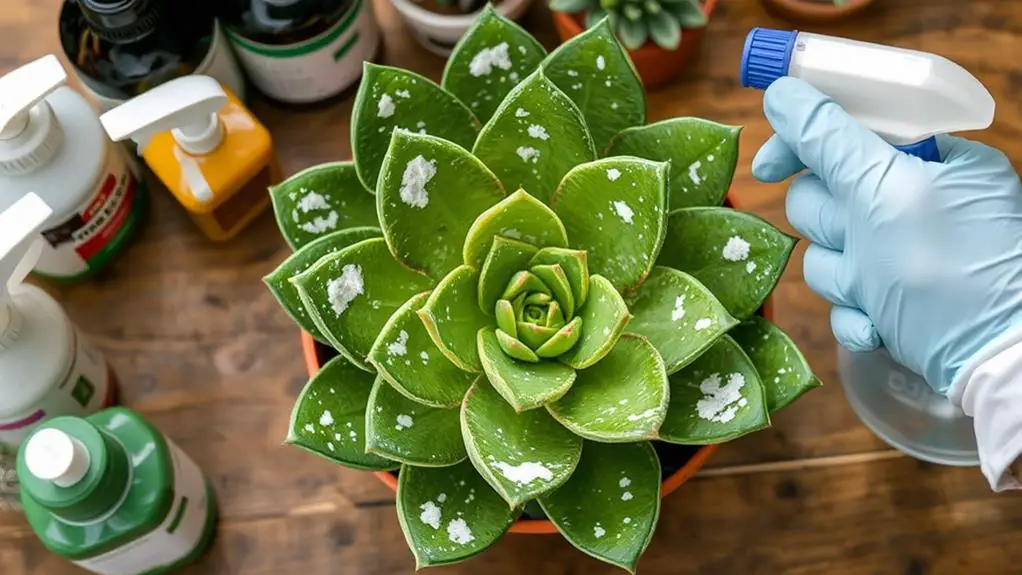
Dealing with powdery mildew on succulents can be challenging, but chemical treatment options offer a robust solution when natural methods fall short. Chemical treatments, especially fungicides, are highly effective in controlling and preventing the spread of this pesky disease.
Look for fungicides with active ingredients like copper or sulfur, as these are particularly good at tackling powdery mildew.
When you're ready to apply a chemical fungicide, make certain to follow the manufacturer's instructions closely. This includes paying attention to dilution ratios and how often you need to apply the treatment. Following these guidelines guarantees the fungicide works effectively without harming your succulent.
Copper fungicides are great for severe infections. They can also be used as a preventative measure before the symptoms become widespread.
On the other hand, sulfur-based fungicides should be applied to all leaf surfaces. Keep in mind, you might need to do follow-up treatments every few days until you see improvement.
In severe cases, you may need to dispose of the affected plant to keep the disease from spreading to your healthy ones.
Post-Treatment Monitoring
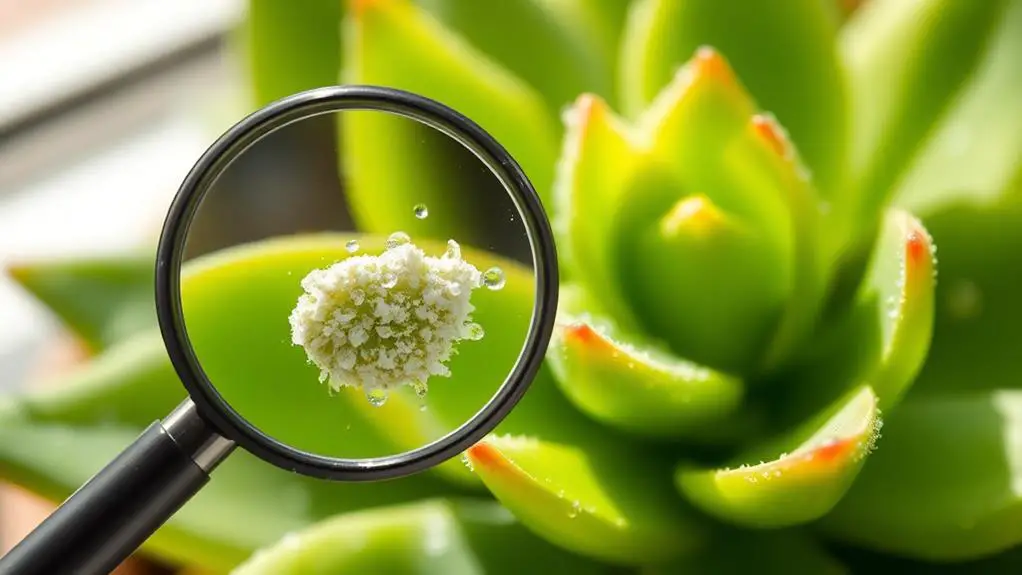
Vigilance is key when it comes to post-treatment monitoring of powdery mildew on succulents. After treating your plants, you should check the affected succulents weekly for any signs of returning symptoms. Look for new white patches or distorted leaves. This helps you catch any issues early and take swift action.
To make certain you're thorough, follow these steps:
- Monitor weekly: Dedicate a specific day each week to examine your succulents closely.
- Check surrounding plants: Powdery mildew can spread easily, so keep an eye on nearby succulents too.
- Maintain proper care practices: Guarantee your plants get adequate sunlight and airflow, which are essential for their recovery.
- Document changes: Keep a record of any improvements or new symptoms. This helps you assess how well your treatment is working.
If you notice that symptoms persist or worsen, don't hesitate to reevaluate the treatment method you used. It might be time to consult with a gardening expert for alternative solutions.
Staying consistent with your monitoring and care practices will give your succulents the best chance to thrive and stay mildew-free.
Preventing Future Infections
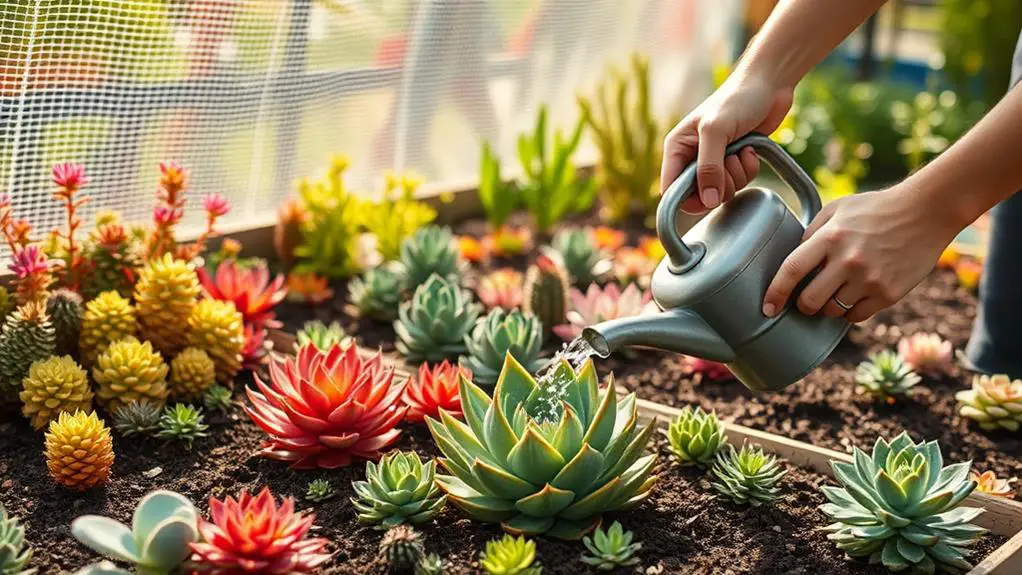
Keeping a close watch on your succulents post-treatment is just part of the process; the next step involves implementing strategies to prevent future powdery mildew infections. First, guarantee proper air circulation by spacing your plants adequately and avoiding overcrowded arrangements. This reduces humidity levels, which powdery mildew loves. Water your succulents during the day so their foliage dries before evening. This minimizes moisture, making it harder for fungal infections to take hold.
Maintaining ideal growing conditions is also essential. Keep temperatures between 70-80°F during the day and lower humidity at night. Regularly inspect your plants for early signs of powdery mildew. If you spot any, promptly remove affected leaves to stop the spread of spores.
Consider applying preventative fungicides, especially before high humidity seasons. This is particularly important if your plants have had powdery mildew before. These steps can fortify your succulents against future outbreaks.
| Strategy | Action | Benefit |
|---|---|---|
| Air Circulation | Space plants adequately | Reduces humidity levels |
| Daytime Watering | Water during the day | Minimizes moisture retention |
| Ideal Growing Conditions | Maintain 70-80°F, lower nighttime humidity | Discourages fungal growth |
| Regular Inspections | Check and remove affected leaves | Prevents spore spreading |
| Preventative Fungicides | Apply before high humidity seasons | Fortifies against future outbreaks |
Frequently Asked Questions
How Do You Get Rid of White Powdery Mildew on Succulents?
Isolate infected succulents to prevent spread. Spray a mixture of baking soda, soap, and water weekly. Use neem oil for minor cases. For severe infections, apply copper or sulfur fungicides. Guarantee proper airflow and well-draining soil.
What Is the Best Treatment for Powdery Mildew?
You should use neem oil or baking soda solution for minor infections. For severe cases, opt for copper fungicide. Remember to follow instructions carefully to avoid damage. Milk treatment also works well for a natural solution.
Can You Use Dawn Dish Soap for Powdery Mildew?
You can use Dawn dish soap for powdery mildew. Mix 1 tablespoon of Dawn, 1 tablespoon of baking soda, and 1 gallon of water. Spray weekly, avoiding high temperatures and testing a small area first to prevent damage.
Can You Wash off Powdery Mildew?
You can try washing off powdery mildew, but it's not very effective. The fungal spores often re-establish quickly. Instead, use fungicides or natural remedies and guarantee good air circulation to prevent recurrence.
Conclusion
You've got this! Treating powdery mildew on your succulents isn't too hard. Start by isolating the infected plants and try natural remedies like baking soda solutions or milk sprays. For tougher cases, use chemical fungicides with care. Keep an eye on your plants and make sure they get good air circulation and proper watering. With these steps, you'll help your succulents stay healthy and vibrant. Happy gardening!

